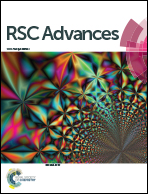Synthesis, crystal structure and magnetic properties of the complex [ReCl3(tppz)]·MeCN†
Abstract
The reaction of the starting materials [ReIIICl3(MeCN)(PPh3)2] or [ReVOCl3(PPh3)2] with 2,3,5,6-tetrakis(2-pyridyl)pyrazine (tppz) in acetonitrile yielded the Re(III) complex [ReCl3(tppz)]·MeCN (1). This complex crystallizes in the monoclinic space group P21/n and its crystal structure consists of neutral mononuclear entities with meridional geometry of the chloride ligands, and the six-coordination of the Re(III) ion being completed by the tridentate tppz ligand. Each metal centre exhibits a highly distorted octahedral coordination with Re–Cl and Re–Ntppz bond lengths covering the ranges 2.3590(9)–2.3606(8) and 1.971(2)–2.096(2) Å, respectively. The magnetic properties of 1 have been investigated in the temperature range 1.9–290 K. They are characteristic of a six-coordinate Re(III) mononuclear complex with d4 low-spin (3T1 ground state). The magnetic data of 1 are discussed through a deep analysis of the influence of the ligand-field, spin–orbit coupling, tetragonal distortion and covalency effects. The second-order Zeeman effect between the non-magnetic ground state (MJ = 0) and higher energy levels (MJ ≠ 0) determines the magnetic susceptibility of 1, the value of the temperature-independent paramagnetic susceptibility being 3378 × 10−6 cm3 mol−1. This value compares well with those reported for other structurally characterized Re(III) complexes.
![Graphical abstract: Synthesis, crystal structure and magnetic properties of the complex [ReCl3(tppz)]·MeCN](/en/Image/Get?imageInfo.ImageType=GA&imageInfo.ImageIdentifier.ManuscriptID=C5RA21466A&imageInfo.ImageIdentifier.Year=2015)

 Please wait while we load your content...
Please wait while we load your content...